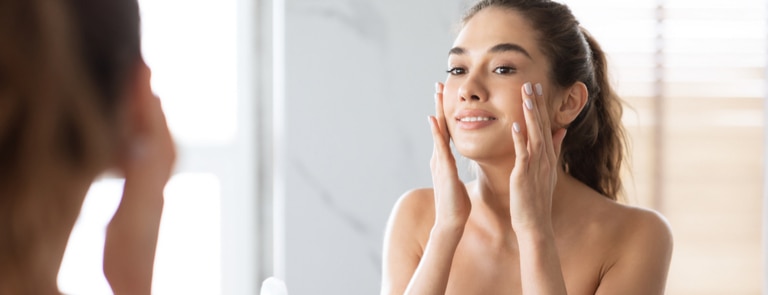15% off €25
What is combination skin? Best skincare routine & products

If you have combination skin, then your skin will be oily in some places and dry in others. It’s the name given to skin that doesn’t fit in one category.
People with combination skin have what’s called a T-zone, which means that if you drew a T shape across your face, the skin inside the T would be oily and the skin outside the T would be dry.
Just because you have combination skin at the moment, doesn’t necessarily mean that you’ll have combination skin forever.
There are plenty of treatments you can try and the majority only require a small adjustment to your daily routine.
In this article, we cover:
- What combination skin is and how it differs from normal skin
- What causes combination skin
- 9 signs that you have combination skin
- How to treat combination skin
- Skincare for combination skin
- Skincare products to look out for if you have this skin type
What is combination skin?
Before diving into the detail, it’s important to highlight what combination skin is.
One of the most common skin types, combination skin is when you have two different skin types skin on your face, and it is generally both oily in parts and dry in parts.
The oily part is on the what’s known as the ‘T-zone’, which can appear excessively oily and shiny across the forehead, down the nose and on the chin.
The rest of the face can appear dry, flaky and it may even be acne prone.
What causes combination skin?
Out of the five different skin types, combination skin is the most common. Here are just a few reasons why you might have this skin type:
-
Your genetics
If you have a family history of skin features like acne, freckles or dry combination skin, these can all be a part of your DNA which is passed down through generations.
Although these genetic irregularities can be altered by preventative skincare measures.1
-
Your products
The skincare products you’re using are too harsh on your nose, chin and forehead.2
If you’re using the wrong kind of moisturiser that contains comedogenic ingredients like coconut oil, shea butter, beeswax etc., it’ll clog up your pores.3
-
Stress
If you’re going through a stressful time in your life, there’s a chance it could be affecting your skin type.
This is largely due to the increased levels of cortisol that are produced when we’re stressed, which trigger a specific hormone that stimulates oil release from our sebaceous glands – leading to spots.4
-
Lack of exercise
If you’re not exercising, your skin might not be receiving as much nourishment as it could be, as increased blood flow helps to nourish the cells and encourage cellular repair and replacement.5
-
Sun damage
When out in the sun, you’re not using adequate protection – which can lead to dried-out skin as the natural supplies of lubricating oils can become depleted.6
What is the difference between normal and combination skin?
We’ve highlighted what combination skin is, with the main characteristic being the presence of both oiliness and dryness on the face.
But how does this differ to normal skin types?
The key difference is that normal skin will feel and appear more even with regards to skin tone and texture, as well as feeling balanced – neither too oily or dry.
Also, normal skin types are less likely to be acne prone.7
9 signs that you have combination skin
With your face having both oily and dry parts you’ll struggle to find skincare products that are effective everywhere.
In the oily areas of your face (your nose, chin and forehead) you’ll be prone to acne breakouts and in the dry areas, your skin will be flaky and tight when wiped with a tissue.
-
You have sensitive cheeks
People with combination skin usually have cheeks that are sensitive to cleansers and can develop the skin condition rosacea which leaves their cheeks red and sore.
-
You develop oiliness very quickly
Even after cleansing, it can only take a short amount of time to feel your skin getting oily again – especially in the T-zone.
-
Moisturiser works well on your cheeks, but not your T-zone
In a lot of instances, moisturisers are designed to work well on the normal skin type.
So if you pick up a moisturiser like this and use it on your skin, you’ll notice that it leaves your cheeks feeling hydrated, but the rest of your face feeling extra oily.
-
You notice a difference in pore size on your face
A lot of people with combination skin can identify and confirm their skin type by assessing the sizes of pores on the different areas of your face.
If your pores are larger on your forehead, nose and chin, but are smaller on your cheeks, it’s likely that you have combination skin.
And this is largely down to the fact that your sebaceous glands are producing too much oil in these areas.8
-
You have a flaky scalp too
If you suffer with pesky dandruff, there’s a high chance that you’ll have combination skin too.
This often means that people with this skin type also have patches of oily skin on their head, as well as dryness on their scalp.
-
You get acne and dryness at the same time
This is a big indicator of combination skin, especially if your spots are located along the T-zone and the drier, flakier areas of the skin are mainly on your cheeks and jawline.
-
You notice changes with the seasons
Celebrity esthetician Lisa Guidi comments on how combination skin can become more noticeable during more extreme weather.
For example, the cold temperatures and dryness of winter to the moist, hot weather of summer.9
-
Your skin texture changes when you apply SPF
Dermatologist Jeanine Downie, M.D. states that something as simple as applying SPF can highlight whether you have combination skin or not.
The key signs to look out for are a shinier forehead, nose and chin – in comparison to well absorbed, ‘normal’ looking cheeks and jawline.10
-
Your skin feels tight
While your skin might be oily in places, it may be lacking in water which could be contributing to the tight, dry feeling in other areas of the face.11
How to manage combination skin
There are lots of things you can do to try and improve the condition of your skin.
-
Exfoliate
You definitely need to start exfoliating if you don’t already, but make sure you take care on your dry skin areas. You don’t want to be too rough.
Handpicked content: 6 reasons why exfoliating is important
-
Use gentler products
It could be that you’re using skin products that are too harsh on your nose, chin and forehead which is making your glands in these areas produce more oil.
Instead, opt for products that have been specially formulated for combination skin and are fragrance-free.
It’s much easier to do this than trying to apply products for oily and dry skin separately as you might accidentally overlap them.
If this happens, you might block your pores and cause another acne breakout.
-
Up your exercise
If you don’t currently exercise, then your skin cells might not be receiving as much oxygen and nutrients as they need.
-
Eat the right foods
As well as exercising more, you should eat more salmon, mackerel, sardines and walnuts as these foods are full of the good fats that your skin needs to be healthy.
-
Wear SPF every day
If you spend a lot of time in the sun and don’t wear adequate protection, then this is something you need to put right straight away.
You will be causing serious, long-term damage to your skin.
-
Try some relaxation techniques
If you think your skin’s condition is down to you feeling stressed, then you should try to relax more if you can – easier said than done, we know.
Maybe spend some time enjoying a hot drink and reading a book or going for a nice walk on a sunny day.
You could give yourself a night in of pampering and see if a nourishing face mask designed for combination skin gives your face a boost.
Skincare routine for combination skin
In order to give your skin the care it deserves, it’s important to use a skincare routine for combination skin specifically.
This involves:
-
Using a gentle makeup remover
This is essential for ensuring that any makeup used during the day has been removed so that it doesn’t clog your pores.
Pro tip: Micellar water is a great product that isn’t too harsh on the skin for this.
-
Using a gentle skin cleanser
Once the makeup is off, or if you weren’t wearing any in the first place, clean your skin with a gentle cleanser to remove any remnants or natural oil buildup.
Pro tip: Try using a product with aloe vera in for a natural soothing and hydrating effect.
-
Using an exfoliator once a week
Using an exfoliator really helps to remove any dead skin, which then in turn helps to keep your pores clear.
Pro tip: Try to avoid using an exfoliator more than once or twice a week as this could irritate the skin.
-
Serum, treatment or moisturiser
If you’re doing this routine in the morning, stick to just moisturiser, but if you have any specialist serums or treatments, now is the time to use them.
Skincare products for combination skin
And the final aspect of caring for combination skin, is understanding which are the best products or more specifically, ingredients, to go for. Here’s what to consider adding to your skincare regimen:
-
SPF
One of the most important skincare products to use if you have combination skin (or any skin type for that matter) is a good quality facial sunscreen.
-
Micellar water
This is a gentle form of makeup remover or cleanser, and is even suitable for people with roseacea.12
-
Salicylic acid
This particular skincare ingredient can help to reduce excess oil and help to combat the bacteria that causes acne.13
-
Hyaluronic acid
This helps to increase the level of moisture in your skin, without adding any extra oil.14 Read more about the best hyaluronic acid products here.
The final say
Combination skin is a very common skin type, and while it can be frustrating for those who have it, thankfully there are a variety of different ways to take care of it.
From choosing specific active ingredients to sticking to a solid skincare routine, understanding your skin type is essential for getting the best out of it.
Last updated: 30 August 2021
- https://drdayan.com/2013/02/08/the-role-of-genetics-skin-type/
- https://odacite.com/blogs/tohealthandbeauty/the-dirty-dozen-top-12-ingredients-to-avoid-in-your-skincare
- https://acneclinicnyc.com/pore-clogging-ingredients/
- https://www.ncbi.nlm.nih.gov/pmc/articles/PMC5722010/
- https://www.usdermatologypartners.com/blog/will-exercising-improve-my-skin/
- https://www.health.harvard.edu/staying-healthy/sun-damaged-skin-a-to-z
- https://www.skinvision.com/articles/how-to-determine-your-skin-type-in-four-easy-steps/
- https://www.ncbi.nlm.nih.gov/pmc/articles/PMC5722010/
- https://www.mindbodygreen.com/articles/how-to-tell-you-have-combination-skin
- https://www.mindbodygreen.com/articles/how-to-tell-you-have-combination-skin
- https://blog.reneerouleau.com/is-your-skin-both-dry-and-oily-the-problem-is-your-products-not-your-skin/
- https://pubmed.ncbi.nlm.nih.gov/32623833/
- https://dermcollective.com/combination-skin-products/
- https://dermcollective.com/combination-skin-products/



